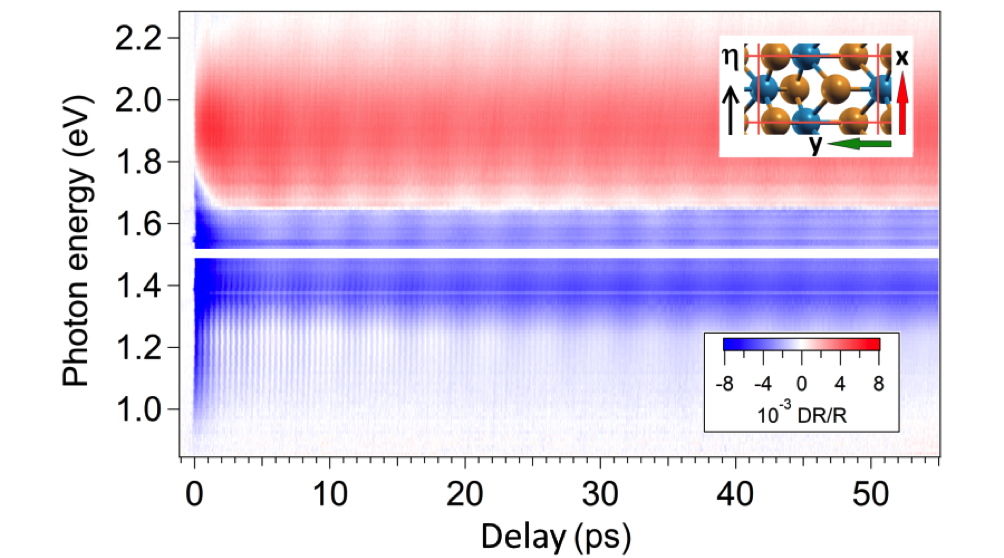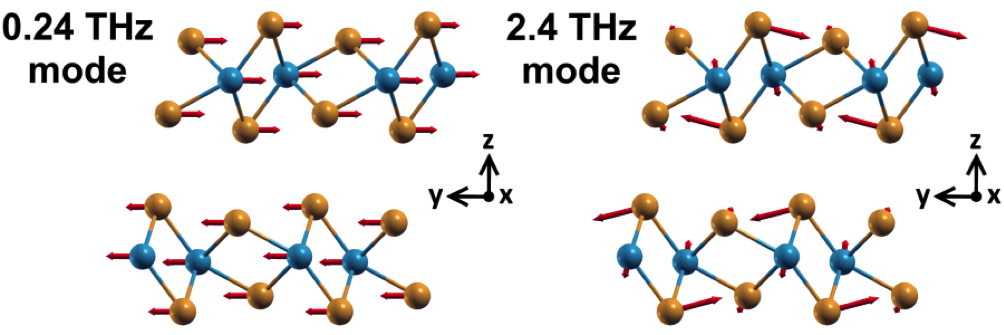PhD Top Stories
Davide Soranzio
Smaller than a picometer: white light to quantify non-equilibrium atomic displacements
Doctoral Programme in Physics
Several fundamental properties of materials, including the electrical and thermal conductivities, are affected by collective atomic vibrations, also known as phonons. Such modes of lattice vibrations are described by their amplitude, frequency, symmetry and phase. When a material is perturbed by suitable light pulses, then lattice vibrations with the same frequency and symmetry may become synchronized over an extended region, originating the so-called coherent phonons. The characteristic time and length scales of such modes are extremely small, of the order of picoseconds and fractions of picometers respectively, i.e. thousandths of a billionth of the fundamental units. To resolve them, it is necessary to perturb the material and sample its response on a very short time interval, before the equilibrium state is re-established. In the case of coherent phonons, laser pulses shorter than a tenth of a picosecond are required. Displacements of the atomic positions smaller than a picometer need lengthy, high precision and accuracy experiments, even using a probe that can directly sample the crystal structure, e.g. x-ray or electron diffraction.
An efficient and faster alternative consists in monitoring the time-resolved reflectivity, in which periodic damped oscillations provide the fingerprints of coherent phonons. Along this line, we report here on a novel approach to estimate the non-equilibrium atomic displacements associated to coherent phonon modes. We revealed and analyzed the modulation induced in the time-resolved reflectivity of a white light probe, comprising wavelengths from the near infrared (1450 nm or 0.85 eV, invisible to the eye) to the visible (550 nm or 2.3 eV, green), as the result of a perturbation of the sample by a near infrared pulse (Figure 1)

Figure 1: The normalized time-resolved reflectivity (DR/R), defined as the probe reflectivity difference due to the presence of a pump pulse, measured with light polarized along the x crystal axis as a function of the time delay between the perturbation and probe pulses and of the white light photon energy
At present, our method is applied to tungsten ditelluride (WTe2), a layered material that has recently gained interest for its electric resistance which becomes unusually high and non-saturating in presence of a magnetic field at low temperatures. Moreover, it has been shown that various of its properties are influenced by strain forces, which can be induced by light pulses, allowing an ultrafast control of its functionalities. Expressly, we focus on two coherent optical phonon modes with ~0.24 THz and ~2.4 THz frequencies. The former is a uniform in-layer shift of the atoms, while the latter involves both in-layer and out-of-layer displacements which depend on the specific atom (Figure 2).

Figure 2: Schematic representation of the detected coherent phonon modes; the arrow orientation indicates the direction of the displacements, while the length expresses the relative shifts of the atoms (tungsten in blue, tellurium in yellow).
The quantification of the amplitude of these vibrations has been achieved combining experiments and computer simulations based on the density functional theory. The oscillatory features of the reflectivity were reproduced, including their dependence on the wavelength and polarization of the white light. This constituted the key to obtain reliable comparisons to quantify the magnitude of the coherent atomic displacements.
This allowed to estimate in ~350 femtometers (thousandths of a picometer) the displacement by the uniform ~0.24 THz coherent phonon mode and in a few tens of femtometers, depending on the specific atom, the ~2.4 THz vibration in our low-intensity excitation conditions.
Our approach allows to evaluate the atomic shifts with a precision of a few femtometers without free tuning parameters, except a scaling factor determined by an overall magnitude comparison between experimental data and numerical simulations. The method is not system-specific and in principle can be extended to any crystalline material, provided that its high-energy optical properties are affected by the coherent motion of atoms. In perspective, our findings provide a useful method to design tailored devices in which the coherent lattice motion is exploited to finely tune the functional properties of semiconducting and metallic systems.
Authors and affiliations
Davide Soranzio1, Maria Peressi1, Robert J. Cava2, Fulvio Parmigiani1,3,4, Federico Cilento42Department of Chemistry, Princeton University, Princeton, New Jersey, USA
3International Faculty, University of Cologne, Cologne, Germany
4Elettra-Sincrotrone Trieste S.C.p.A., Basovizza, Italy
Contact
Davide Soranzio, email: davide.soranzio@phd.units.itReference
D. Soranzio, M. Peressi, R. J. Cava, F. Parmigiani, and F. CilentoUltrafast broadband optical spectroscopy for quantifying subpicometric coherent atomic displacements in WTe2
Phys. Rev. Research 1, 032033 (2019)
DOI: 10.1103/PhysRevResearch.1.032033
Informazioni aggiornate al: 18.2.2021 alle ore 10:21
Contact: Webmaster - Università di Trieste pagina curata da: Research Doctorate

Piazzale Europa, 1 - 34127 - Trieste, Italia -
Tel. +39 040 558 7111 - P.IVA 00211830328
C.F. 80013890324 - P.E.C. ateneo@pec.units.it



